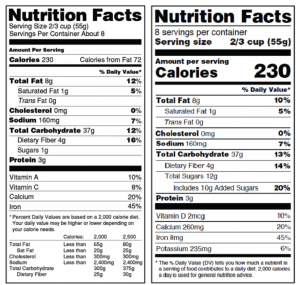
Disclosure: This post was sponsored by the Registered Dietitians at the Canadian Sugar Institute, and I have received monetary compensation. As always, my own professional opinions and views are expressed.
I love food! And a big part of my job as a dietitian is to help Canadians love food too! I’m passionate about translating the complex science of nutrition into everyday healthy eating tips that make sense and are easy for people to follow. So when my dietitian colleagues at the Canadian Sugar Institute invited me to a hands-on cooking Sweet Spot Workshop with Chef Claire Tansey, I was excited to learn more!
First, some nutrition background
Recently, Health Canada announced new guidelines for sugars and also some new changes to how sugars will be shown on food labels.
Specifically, for the first time ever, there is a Daily Value for sugars, set at 100 grams. According to Health Canada, 100 grams isn’t meant to be the recommended amount of sugars to consume, but instead it’s an amount of sugars that is consistent with a healthy eating pattern. On food labels, the sugars content of the food will be listed in grams (g) and also as a percent of the Daily Value (% DV) (see below for the “NEW” image of the Nutrition Facts table).
Now remember that 100 grams is the total from all types of sugars:
- naturally occurring sugars (like the sugars found in fruit, veggies and unsweetened milk products);
- added sugars (like different sugars that are added when cooking or processing food); and
- free sugars (these are added sugars plus sugars that are naturally found in honey, syrups, fruit juices and fruit juice concentrates).

Now, the food!
So what exactly does 100 grams of sugars look like when it comes to real food? That’s where the Sweet Spot Workshop comes in. Dietitians teamed up at the workshop to make a day’s menu of food – adding up to 100 grams of sugars, staying within the sodium and fat recommendations, and totalling no more than 2,000 calories (the average number of calories needed by an adult). So here’s what we made. All recipes were inspired by Claire’s latest cookbook Uncomplicated.
Breakfast

Instant Bircher Museli – made with oats, unsweetened apple juice, nuts and fresh pears and paired with a single serving of Greek yogurt – 28 g sugars
Lunch

Chilled Cucumber and Sesame Noodles with Tofu – made with soba noodles, maple syrup, sesame oil, cucumbers, tofu and edamame, served with sweet and sour bok choy – 7 g sugars
Snack
Assorted berries and cherries with a fruit / kale Greek yogurt smoothie – 29 g sugars
Dinner

Coconut Chicken Curry – made with chicken, coconut milk, ginger, curry paste, tomatoes and peas, served with steamed broccoli – 7 g sugars
Dessert

Plum-Almond Galette – made with fresh, local plums – 30 g sugars
The bottom line
You can definitely enjoy a variety of healthy meals with a small dessert AND stay within 100 grams of sugars for the day! Enjoy!
Photos by Flora Wang.


